Video Marketing Strategy for Brands in Singapore

Video Marketing Strategy for Brands in Singapore: How to Build Campaigns That Perform
Your boss says, “Let’s make a video.”
You nod, open up a brief, and start searching for vendors.
But then the questions hit you:
- What’s this video actually supposed to do?
- Will it reach the right people?
- How do I even know if it worked?
Welcome to the modern marketer’s dilemma.
You're expected to create content, but no one gives you the strategy to make it successful.
If you're a general marketer at a growing brand in Singapore, you’re probably not a content specialist. You’re running performance campaigns, juggling digital ads, and now you're in charge of video too.
Everyone agrees video is powerful.
But few explain how to use it to get real results.
That’s what this guide is here for.
We’ll walk you through how to:
- Set clear, measurable goals for every video
- Match your video content to the customer journey
- Pick the right platforms based on your audience
- Track performance using metrics that matter
- Prove ROI and keep improving over time
By the end, you’ll know how to:
- Brief your videos with confidence
- Track their impact
- Report outcomes that actually help your business grow
Let’s start with the foundation of any successful video campaign: setting clear goals.
Set Clear Video Marketing Goals That Drive Results
Before you decide what your video should look like, it's important to figure out what it's meant to do.
This step often gets skipped. When timelines are tight or leadership says, “Let’s just get something out,” the pressure to move quickly can take over. But skipping goal-setting is one of the biggest reasons videos underperform. Without a clear objective, it’s hard to measure success, and nearly impossible to prove return on investment.
Why Goals Come Before Storyboards
Think of a video as part of a campaign, not just a standalone piece of content. You wouldn't launch a paid campaign without clear KPIs. The same applies here.
In fact, video deserves even more strategic thinking. It’s one of the most visible, and often one of the most expensive, pieces of content your brand will create.
Here’s something many marketers forget: not every video needs to sell. And not every one should.
Trying to turn a brand awareness video into a conversion tool usually leads to confusion. The creative direction feels unclear, the messaging doesn’t land, and the results don’t reflect what stakeholders expected.
The Three Core Video Goals
Most marketing videos fall into one of three categories:
- Awareness
Designed to introduce your brand or product to new audiences.
Use this when launching something new, entering a different market, or updating your brand identity.
Formats might include brand films, teaser videos, or story-led ads. - Consideration
Helps build trust and guide people closer to making a decision.
Ideal for explaining complex offers or standing out in a competitive space.
Formats often include explainer videos, testimonials, or how-to content. - Conversion
Aims to drive specific actions, such as sign-ups, purchases, or demo bookings.
Best for retargeting or promoting proven offers to warm audiences.
Formats include product demos, case studies, or user-generated content.
Use Goals to Shape the Entire Video Strategy
When you start with a clear goal, everything else falls into place.
- Your message aligns with the viewer’s mindset
- Your call to action fits the customer journey
- You choose the right platform for your audience
- You track performance with relevant metrics
At Epitome Collective, we use what we call the Goal-First Lens. It’s a method that ensures creativity always connects back to business impact. Because in the end, a video isn’t successful just because it looks good. It needs to perform.
So before you brief a single scene, ask yourself and your team:
What does this video need to achieve? And how will we know if it worked?
Next, we’ll explore how to connect your video goal to the customer journey, so your content reaches the right audience, in the right way, at exactly the right time.
Map Video Content to Your Marketing Funnel

Once you’ve defined your video’s goal, the next question is just as important:
Where in the customer journey does this video belong?
Without this clarity, you risk sending the right message at the wrong time.
Why the Funnel Matters
Every customer goes through a few key stages before they make a purchase. This is what we call the marketing funnel.
Your video should meet people where they are in that journey, not where you hope they are.
Trying to convert someone who’s never heard of your brand is like asking someone to marry you on the first date. It’s too soon.
At the same time, showing a general brand story to someone who’s ready to buy might slow them down.
The 3 Stages of the Video Marketing Funnel
Top of Funnel (TOFU): Awareness
Audience mindset: “I’ve never heard of you.”
At this stage, you’re speaking to cold audiences. These are people who aren’t actively looking for your product but could be a great fit. The goal is to make a strong first impression that builds curiosity and brand recognition.
Use videos such as brand films, teaser ads or story-driven lifestyle content.
Focus on stopping the scroll, sparking interest and introducing your brand identity.
Track metrics like views, reach, watch time and video completion rate.
Example:
A lifestyle brand releases a 30-second cinematic spot that showcases its look, values and vibe. There is no hard sell, just an emotional introduction to what the brand stands for.
Middle of Funnel (MOFU): Consideration
Audience mindset: “I know who you are, but I want to know more.”
Here, your audience is starting to evaluate whether your brand fits their needs. They are considering options, comparing you to others and looking for reasons to trust you.
Use videos such as explainers, testimonials, behind-the-scenes clips or FAQ videos.
Focus on answering questions, showing credibility and building trust.
Track metrics like click-through rate, engagement, time on page and repeat views.
Example:
That same lifestyle brand shares a behind-the-scenes video showing how their products are ethically made, including interviews with designers and footage from the workshop.
Bottom of Funnel (BOFU): Conversion
Audience mindset: “I’m ready to buy. Just give me a reason.”
Now your audience is warm. They have seen your content, they like your brand and they are close to making a decision. Your job is to help them take the final step.
Use videos such as product demos, user-generated content, retargeting clips or offer videos.
Focus on showing value, reducing friction and prompting immediate action.
Track metrics like leads, purchases, conversion rate and cost per acquisition.
Example:
The brand runs an Instagram ad showing real customers wearing their best-selling items, paired with a limited-time offer and a clear call to action such as “Shop Now.”
Quick Reference: Funnel-to-Format Planning Table
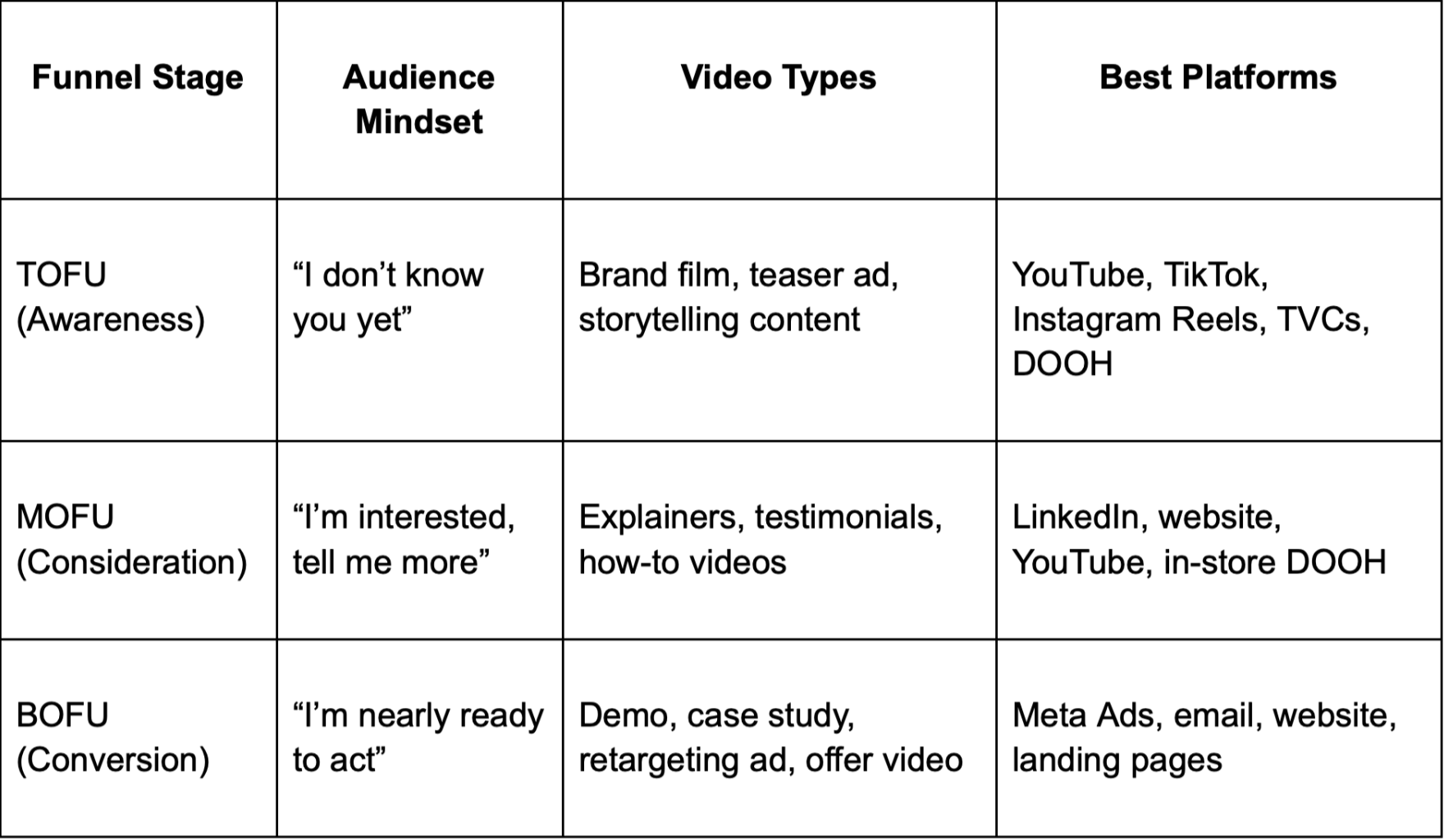
Do not expect one video to do everything. That often leads to mixed messaging and a confused audience.
Instead, build a system of videos. Give each one a specific role in guiding your viewer from awareness to action.
Next, we will help you focus even further by defining who your audience is and where they spend their time. That way, you can show up exactly where they already are.
Identify Your Target Audience and Platforms for Video Marketing

Once you’ve set a clear goal and mapped your video to the right stage of the funnel, the next step is to answer two crucial questions:
- Who exactly are we trying to reach?
- Where do they spend their time?
Most videos don’t fail because the content is bad. They fail because they are aimed at the wrong people or published on the wrong platform.
Let’s break this down step by step.
Step 1: Know Exactly Who You're Talking To
When planning a video, don’t start with what you want to say. Start with who you are speaking to.
That means defining a specific, strategic audience. Avoid vague labels like “young people” or “business owners” and instead build an actionable profile based on real insight.
There are three things to consider:
1. Demographics
These are the basic identifiers that shape behaviour:
- Age range
- Gender
- Location
- Job title or industry
- Income level or spending habits
Example: A lifestyle apparel brand in Singapore targeting women aged 25 to 40 who live in urban areas and have mid-to-high disposable income.
2. Psychographics and Pain Points
This is about what your audience thinks, feels and struggles with.
Ask yourself:
- What are they frustrated by?
- What are they searching for?
- What do they care about most?
Example: The same brand may target women who value sustainable fashion but find it hard to discover stylish options that feel premium without being overpriced.
Understanding this helps you craft messaging that speaks directly to their values and shows how your brand fits their lifestyle.
3. Stage in the Buyer Journey
Consider how familiar your audience is with your brand.
- If they are brand new, focus on emotional or educational messaging (TOFU)
- If they already know you, show credibility and value (MOFU)
- If they are ready to act, be direct and clear about your offer (BOFU)
You don’t need ten different personas. One focused, well-defined audience per campaign is enough. This clarity shapes your script, visuals and platform choices with precision.
Step 2: Pick the Right Platform for That Audience
Different people use different platforms, and they engage with content in different ways depending on where they are in the funnel.
Today’s videos don’t live on social alone. Depending on your audience and goals, the right format may be a homepage explainer, a DOOH loop in Orchard, a TVC, or even a main-stage opener at your brand’s flagship event.
Here is a simple guide to the major video platforms and how they perform in Singapore:
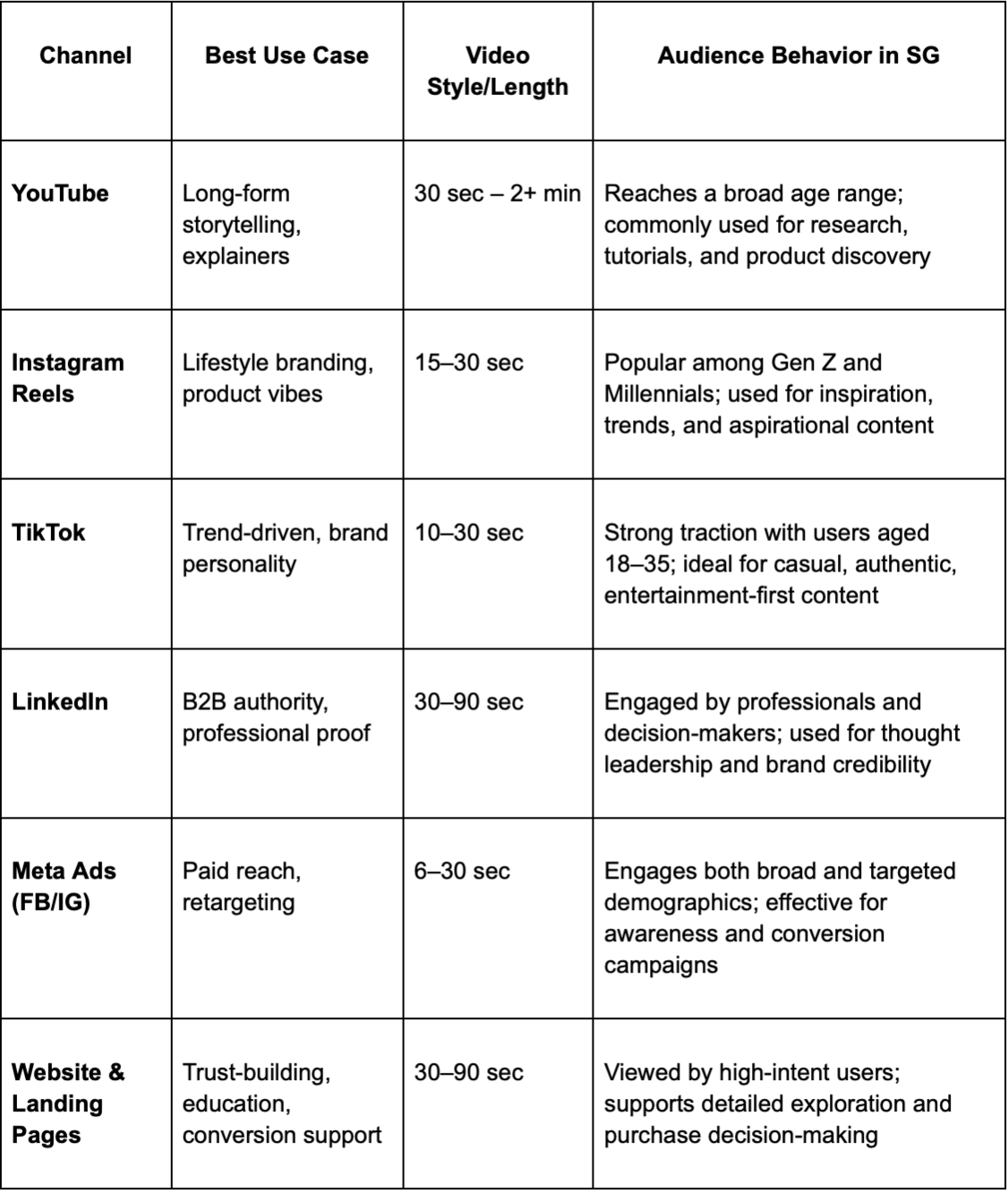

Each platform has its own culture and purpose. A polished brand film may perform well on YouTube, but feel out of place on TikTok where authenticity and speed are more important.
Step 3: Align Audience, Platform, and Funnel Stage
The most effective videos are built for a specific moment in the buyer journey and tailored to both the platform and the audience’s mindset.

Example in Action:
Let’s say our lifestyle apparel brand wants to launch a new sustainable collection.
- They start with a 30-second lifestyle video on Instagram Reels that highlights everyday women wearing the clothes in real-life moments. This introduces the brand’s look and feel.
- Next, they publish a behind-the-scenes YouTube video showing the eco-friendly materials and design process, including short interviews with the team.
- Finally, they run a Meta ad featuring real customer reviews, paired with a limited-time discount and a clear CTA such as “Shop the Collection Now.”
The Goal: Show the Right Video to the Right Person in the Right Place
If your video reaches the wrong audience or appears on the wrong platform, it will not matter how well it is made. Distribution matters just as much as the content itself.
At Epitome Collective, we see this all the time. Strong creative underperforms, not because it lacks quality, but because it is not published where the audience is actually active.
Next, we will show you how to track whether your video is actually working. That way, you can measure progress, report with confidence and make smarter decisions with every piece of content you produce.
Track the Right Video Marketing Metrics For Your Brand Goals

Once your video is live, the question always comes:
“So... how did it perform?”
The answer depends entirely on your original goal.
If you don’t have clear metrics that align with your video’s purpose, you risk overpromising or underreporting. Even worse, your stakeholders may walk away unsure whether the video was a good investment.
Let’s break down exactly which metrics matter, and when to use them.
Why Views and Likes Aren’t the Whole Story
Views, likes and shares are often the first numbers people look at. For awareness-stage content, these can absolutely be useful. Metrics like reach and watch time are strong indicators of whether your video is grabbing attention.
But here’s the catch. These metrics only tell part of the story.
A high view count doesn’t always mean your message landed. A “viral” video might create buzz, but have little impact on leads or conversions. On the flip side, a lower-view video could drive strong action and outperform everything else in your campaign.
The key is to match the metric to the intent. Views matter when visibility is the goal. But they should not be used to measure success at every funnel stage.
Match Metrics to Funnel Stage and Purpose
Here’s how to track success depending on where your video fits in the marketing funnel.
Top of Funnel (TOFU): Awareness Stage
Goal: Reach new people and introduce your brand
At this stage, you’re targeting cold audiences. You want to make a strong first impression and build visibility.
Track:
- Impressions: How many times your video was displayed
- Views and View Rate: Who watched, and for how long
- Watch Time or Completion Rate: Did they finish the video?
- Engagement: Likes, shares, comments, reactions
What success looks like:
If people are watching for longer, completing the video and engaging with it socially, your content is making an impact.
Middle of Funnel (MOFU): Consideration Stage
Goal: Educate, build trust and support decision-making
Here, your audience already knows your brand. They’re exploring whether your product is right for them.
Track:
- Click-Through Rate (CTR): Are viewers visiting your site?
- Time on Page or Session Duration: Are they staying and reading more?
- Engagement Rate: Are they commenting or saving the video?
- Repeat Views: Are people coming back to rewatch?
What success looks like:
Clicks, longer time spent on site and returning viewers are strong signals your video is helping people evaluate your offer.
Bottom of Funnel (BOFU): Conversion Stage
Goal: Drive direct action like sign-ups, leads or purchases
At this point, your audience is warm. The video should remove hesitation and make action easy.
Track:
- Conversion Rate: Percentage of viewers who take the desired action
- Cost Per Lead (CPL) or Cost Per Acquisition (CPA): Especially important for paid video campaigns
- Return on Ad Spend (ROAS): How much revenue is generated from your spend
- Form Fills, Purchases or Checkout Events: Specific actions tied to business outcomes
What success looks like:
You’re seeing real business impact. Leads are generated, sales are made or demo bookings are completed.
Epitome Collective’s Metrics Matrix: What to Measure and When
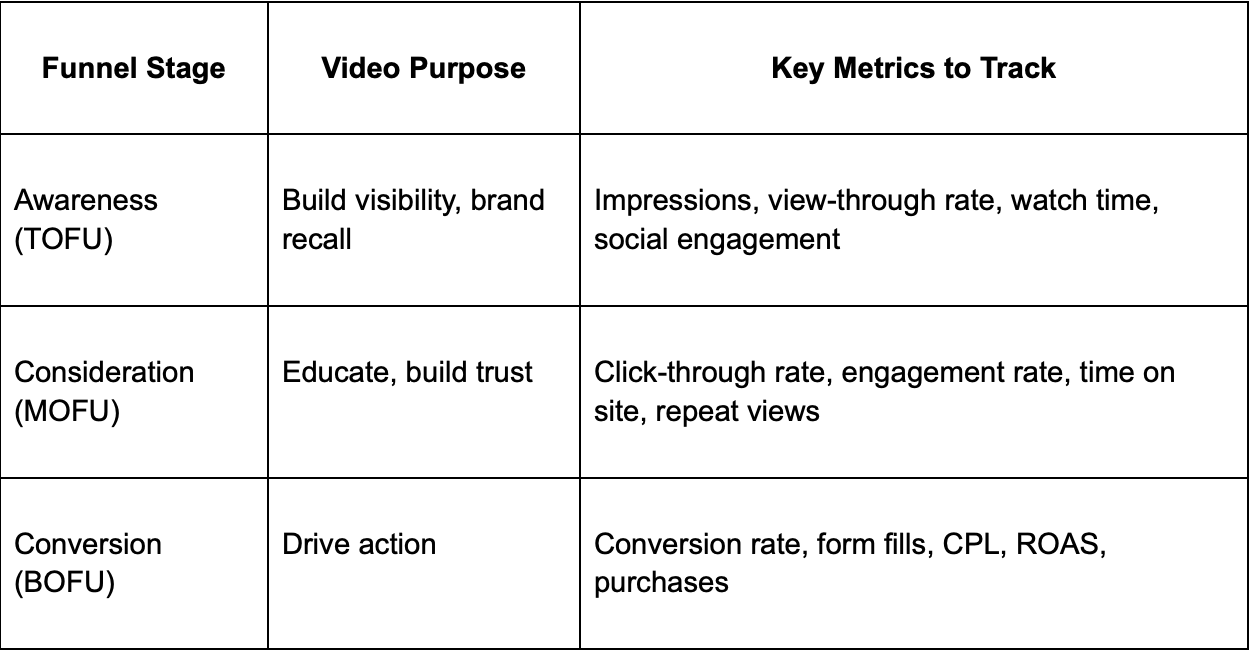
When goals and metrics don’t match, reporting becomes confusing. Campaigns can look like failures even when they are doing their job well.
The solution is simple.
Define your goal. Track the right metric. Report with clarity. Make better decisions.
Up next, we will show you how to tie video performance to real business outcomes by measuring ROI.
ROI on Your Video Marketing Campaigns
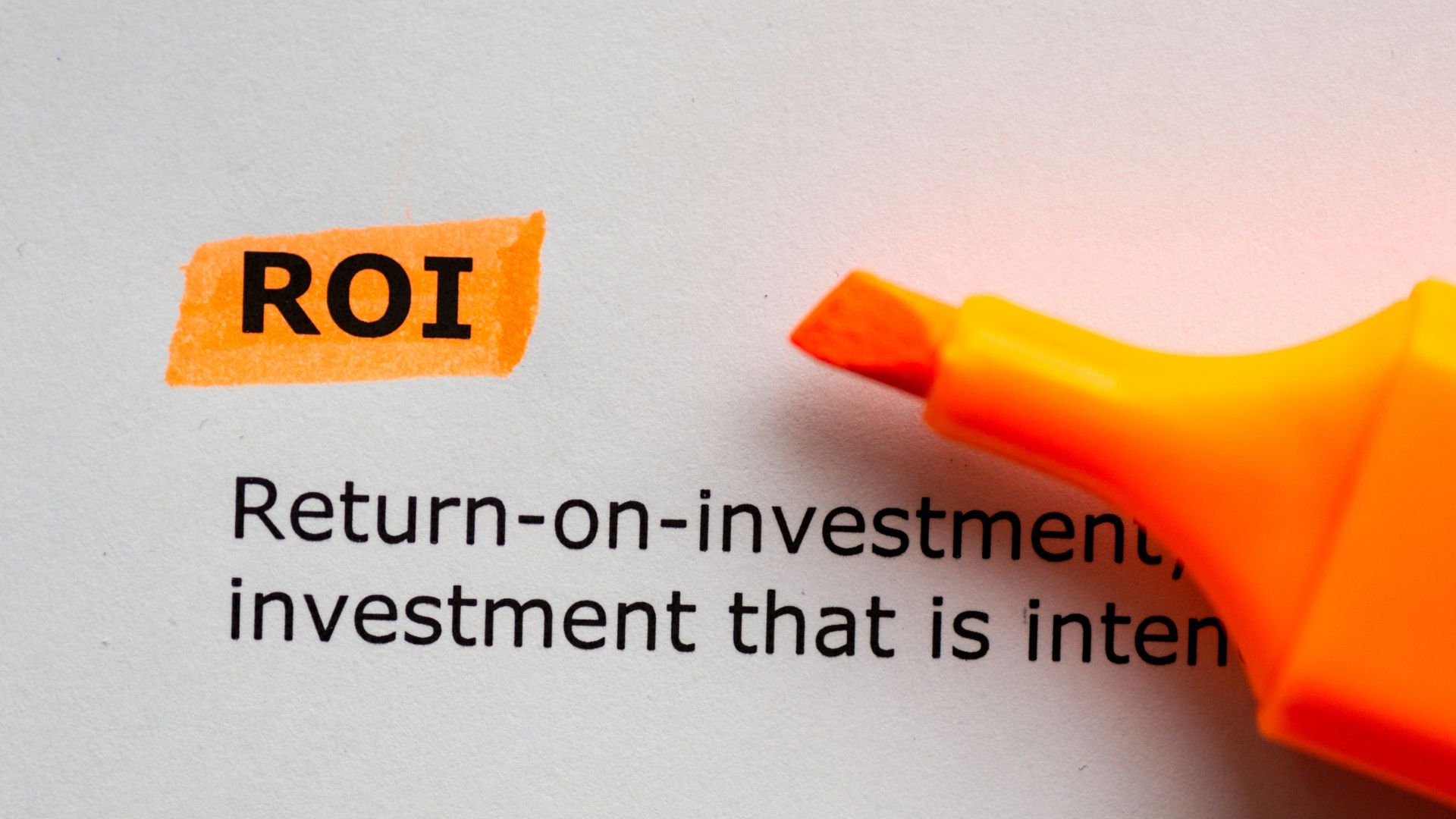
Once your video is live and the metrics start coming in, the next big question follows:
“Was it worth it?”
This is where many video marketing efforts stumble. It is not because the video didn’t perform, but because no one linked that performance back to business value.
For general marketers, this part can feel intimidating, especially if you are not used to justifying creative spend with hard numbers. Let’s break it down in a way that’s simple and actionable.
What Does ROI in Video Marketing Really Mean?
ROI, or return on investment, measures what you gained compared to what you spent. That return could be financial, such as revenue from sales, or strategic, like brand recognition or trust.
It is not always about revenue. The return depends on your original goal. If your video was designed for awareness, your return might be reach or recall. If it was meant to convert, then revenue or leads matter more.
ROI can be:
- Tangible: Leads, purchases, bookings
- Intangible (but trackable): Brand recall, more time spent on site, better email open rates, higher engagement on ads
What matters most is aligning the return to your video’s purpose.
If your video was built for awareness, don’t judge it based on sales. If it was built for conversion, don’t settle for views.
A Simple Formula to Start With
If your campaign is tied to revenue, especially in the conversion stage, use this formula:
ROI (%) = [(Revenue from Video – Cost of Video) / Cost of Video] x 100
Example:
- Video production cost: $5,000
- Revenue from leads tied directly to the video: $15,000
ROI = [(15,000 - 5,000) / 5,000] x 100 = 200%
This is especially useful for paid video campaigns, such as Meta or YouTube ads, where you can track clicks, conversions and spend.
But what if your video isn’t designed to drive sales directly?
Epitome Collective’s ROI Validation Matrix
Not all value is financial. Here's how we help clients validate ROI based on the video’s objective:
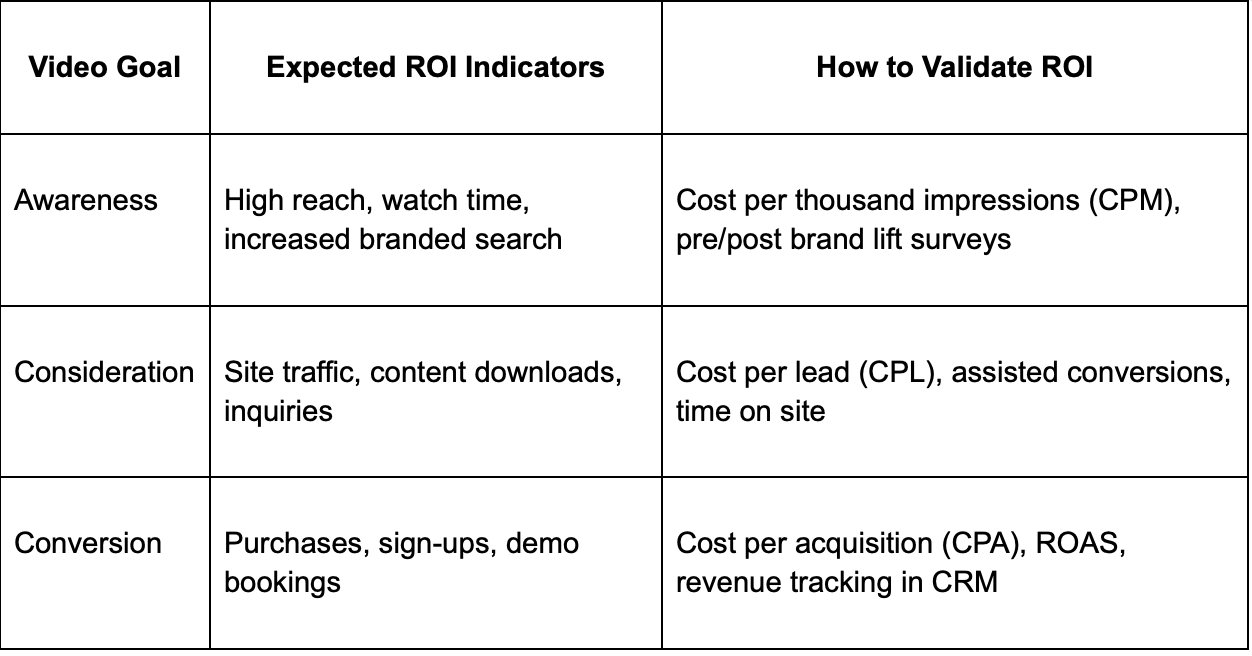
This approach connects your campaign performance to business impact, even when dollars are not the only outcome. It also gives you confidence when reporting results to leadership.
What Impacts ROI in Video Marketing?
Video ROI is not just about the content. Multiple factors play a role in how well your campaign performs:
- Clarity of Goal: Was the video tied to a specific business objective?
- Targeting: Did it reach the right audience?
- Creative Execution: Was the message clear and engaging?
- Distribution: Was the video promoted on the right platforms?
- Call-to-Action: Did the video give people a clear next step?
Even the most beautifully produced video can underdeliver if it lacks strategic direction or is shown to the wrong audience.
Don’t Expect Instant ROI, But Know What to Look For
Not every video will generate immediate results. Some are slow-burn campaigns. Others play a supporting role in the customer journey.
What matters most is that you:
- Track the right metrics based on your video’s goal
- Understand what success looks like before you launch
- Learn from the data and apply those insights to your next campaign
Speaking of which, next we will look at how to optimise your videos using performance data so each one performs better than the last.
Optimise Your Video Strategy with Performance Data

You’ve launched your video. You’ve tracked the right metrics. You may have even proven ROI.
Now what?
This is the point where many marketers stop. In reality, it is where the most valuable work begins. This is your chance to take what the data tells you and use it to make your video even more effective.
The truth is, no video is perfect the first time. Even your best-performing content can be improved. And if a video underperforms, you often don’t need to scrap it. You just need to adjust it.
The goal of optimisation is not to fix failure. It is to keep improving performance through small, smart changes.
Why Optimisation Matters
Video production takes time and budget. The most efficient marketers know how to extend the value of every asset.
Optimisation helps you:
- Repurpose your video across more platforms
- Make improvements based on data, not just guesswork
- Test new versions or hooks to increase impact
When done well, optimisation turns a single video into a long-term engine for better performance and stronger ROI.
Step 1: Identify What’s Not Working and Why
Start by reviewing the data based on your video’s original goal. Look for specific patterns that can guide your next move.

The key is not to guess. Let user behaviour guide small, specific improvements.
Step 2: Test Small Changes That Make a Big Impact
You don’t need to rebuild your entire video. Often, changing just one element can improve performance.
Test things like:
- The hook: Try a different opening shot, scene, or voiceover line
- Video length: Compare a 60-second version to a shorter 30-second cut
- CTA wording: For example, “Book Now” versus “Try a Free Demo”
- Thumbnail design: Test multiple visuals to see which gets more clicks
- Captions or subtitles: Add or adjust them to improve clarity and accessibility
If you’re running paid campaigns, platforms like Meta and YouTube make A/B testing easy with small variations in budget and targeting.
Step 3: Repurpose High-Performing Content
If a video is doing well, don’t stop there. Stretch its value by turning one strong piece into multiple assets.
You can:
- Cut it into shorter clips for Instagram Reels, TikTok, or Stories
- Turn customer testimonials into case studies or website banners
- Use still frames, quotes, or captions for carousel posts
- Repurpose explainer videos into blog posts or email sequences
This approach lowers your cost per asset and gives your audience more ways to engage with your message.
Step 4: Carry Insights Into Your Next Campaign
Optimisation is not just about tweaking a single video. It is about building a smarter system for everything you create going forward.
Ask questions like:
- Which platform delivered the best results?
- Which message or topic resonated most with your audience?
- What CTA drove the highest number of conversions?
Document what you learn. Use those insights to brief your next video with more focus and clarity.
Over time, you will move from guessing what works to knowing what works. That is how you build a video strategy that performs consistently, based on real data rather than chance.
Video is not a one-time project. It is a dynamic, evolving part of your marketing engine.
If you treat every campaign as a learning opportunity, you will keep getting more out of each video. Not just in performance, but in value.
Conclusion: Build Smarter Video Campaigns That Actually Perform
Let’s recap what we’ve covered:
- Start with a clear goal. Know exactly what you want your video to achieve.
- Map your video to the funnel. Don’t expect one video to do everything.
- Know your audience and platforms. Show up where your viewers already are.
- Track the right metrics. Measure performance based on purpose, not popularity.
- Prove ROI. Connect creative output to real business outcomes.
- Optimise continuously. Use data to improve every campaign over time.
This isn’t just about making content. It is about building a performance-driven video system. One that turns strategy into creative, creative into results, and results into future growth.
And here is the good news. You don’t have to do it all alone.
At Epitome Collective, we help brands in Singapore bridge the gap between creativity and performance. Whether you need support for a single campaign or a long-term content partner, we bring the structure, flair and strategy to make every video count.
.jpg)
Need a second opinion on your current video plan? Or help building one from scratch?
Get in touch with us. We’ll help align your content with your business goals and show you what’s possible when strategy comes first.


